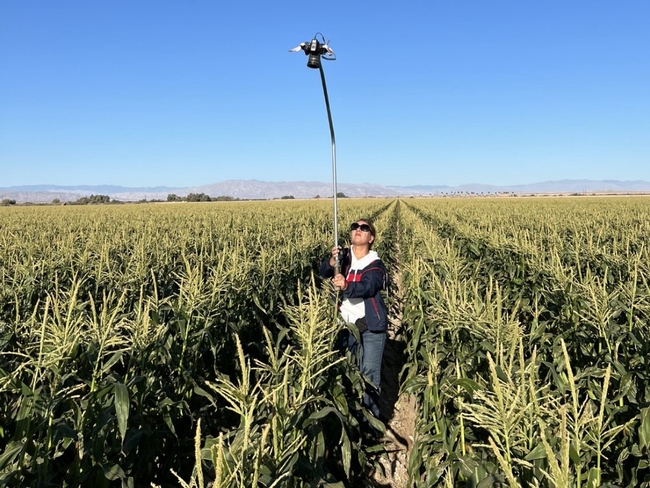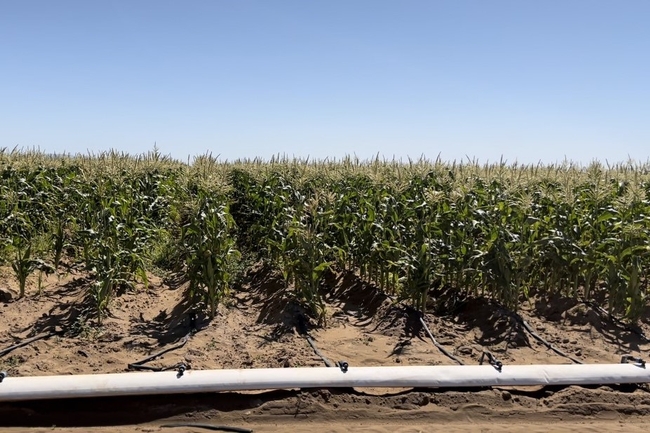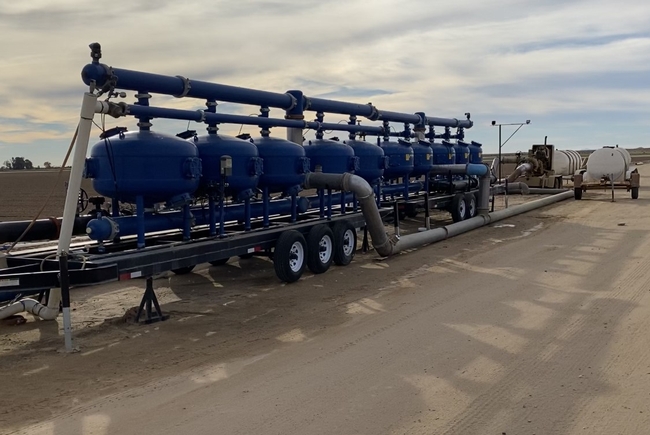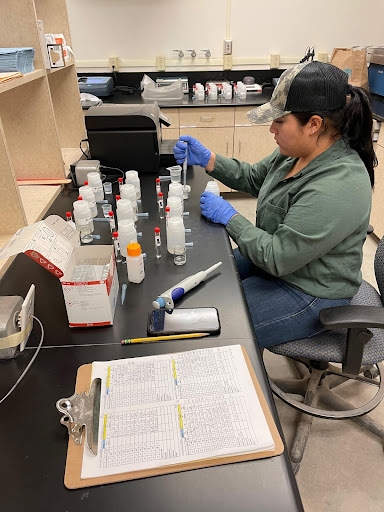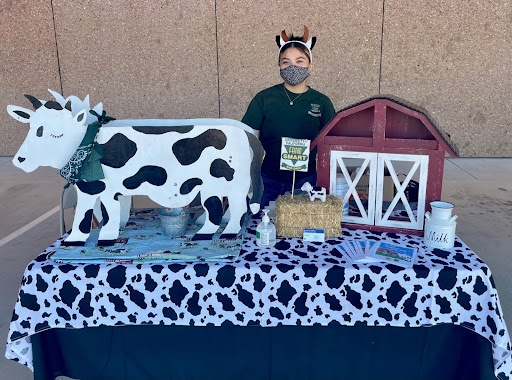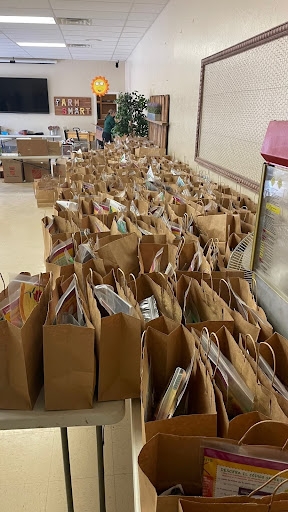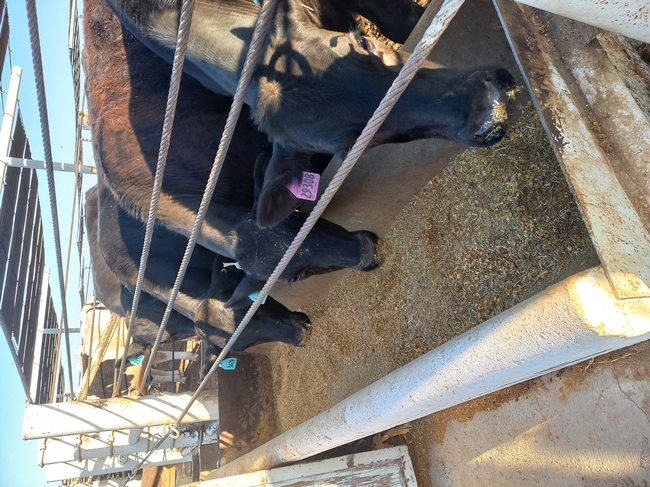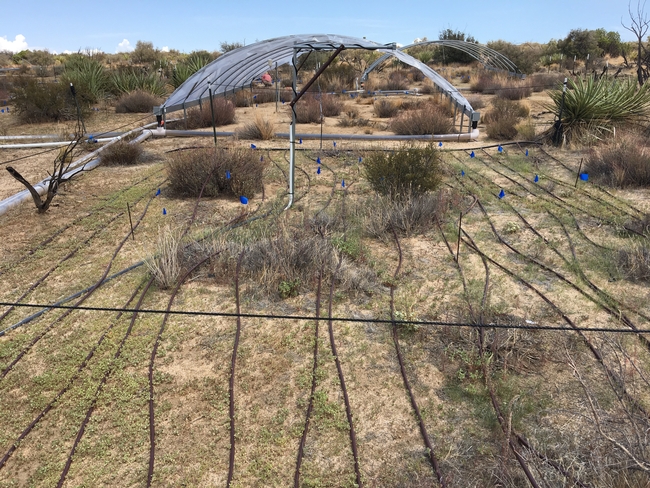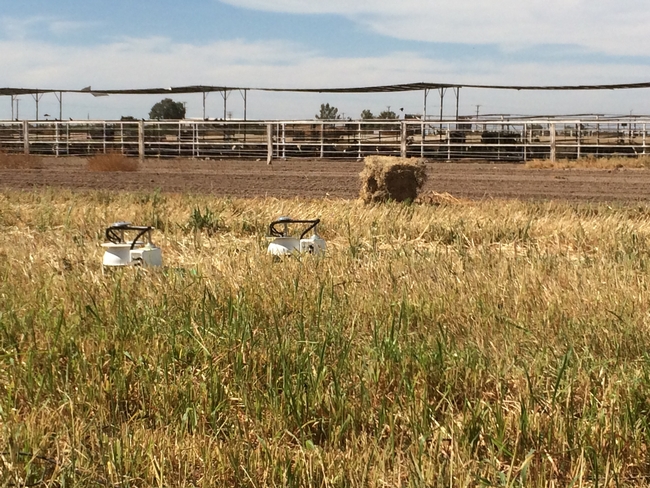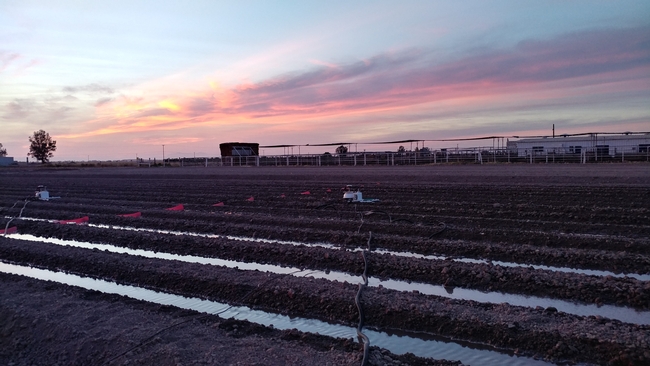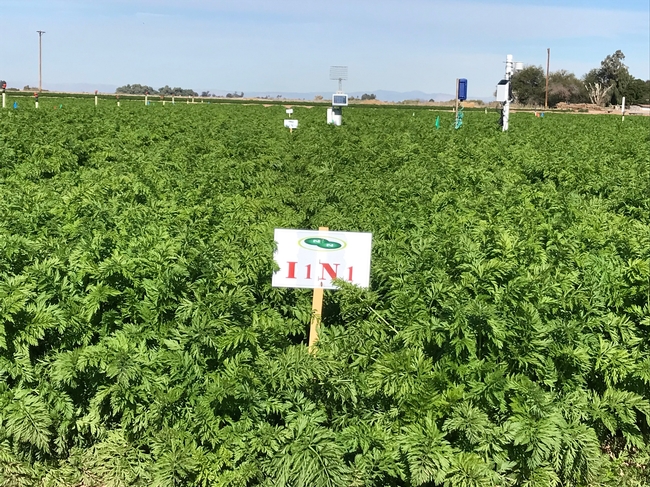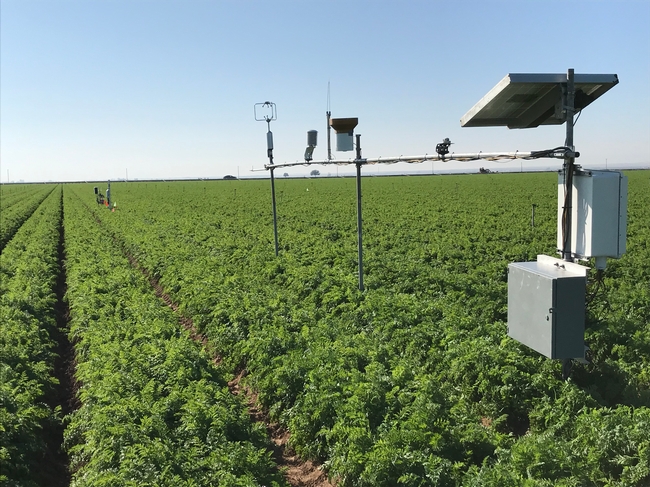Posts Tagged: desert
Drip-irrigation study sees ‘huge’ reduction in water, fertilizer use for sweet corn
Study by UCCE advisor in Imperial County also shows 5% increase in yield
A new study suggests that drip irrigation for sweet corn can significantly conserve water, reduce fertilizer use and boost crop yield in the low desert of California – and likely in other areas of California with similar conditions.
Although Imperial County is California's top sweet corn-producing county, with about 8,000 acres planted on average each year, irrigation methods for this crop have been rarely studied in this region (or anywhere else in the state), according to Ali Montazar, UC Cooperative Extension irrigation and water management advisor for Imperial, Riverside and San Diego counties.
Montazar conducted a study in the Imperial Valley over two crop seasons, 2020-21 and 2021-22, to demonstrate and quantify the potential benefits of switching to drip irrigation from the more common furrow irrigation method. The study, available in a recent issue of UC Agriculture and Natural Resources' Agricultural Briefs, will be published in a future issue of Vegetables West.
“I'm hoping with this project we can encourage growers to adopt it, because it seems very promising,” said Montazar, noting that drip irrigation is a “new practice” for sweet corn in California.
Among the 11 commercial sweet corn fields in the study over the 2021-22 season, the six that were under drip irrigation used, on average, 37% less water than the five under furrow irrigation. In absolute terms, the drip-irrigated fields saw an average water savings of 2.2 acre-feet per acre; for Montazar, who has studied drip for a variety of crops in the Imperial Valley, that was an astonishing result.
“I've worked with drip on processed onions, lettuce, alfalfa, spinach … we've never seen a figure like 2.2 acre-feet per acre, that's huge,” he said, attributing the dramatic drop-off to the high volume of water required to furrow-irrigate the sandy soil in the Imperial Valley.
More efficient irrigation also means less fertilizer is needed – a boon to the environment and Salton Sea water quality, as well as growers' bottom line. With fertilizer prices continuing to rise, sweet corn growers using drip could see a substantial 25% cost savings on fertilizer expenses – about $150 per acre less – compared to furrow irrigation, according to Montazar's study.
And by relieving plants of the stress from over- and under-irrigated conditions, drip irrigation helps keep soil moisture at its “sweet spot” – resulting in a 5% increase in marketable crop yield for sweet corn in the study.
“When we have a better, more efficient irrigation system, we can maintain soil moisture at a desired level, over time and space,” Montazar explained.
Because the benefits of drip appear to be linked to soil conditions (sandy loam, and other light soils), Montazar believes that this irrigation practice could deliver relatively similar water and fertilizer savings and improved crop yield in other regions across California, regardless of climactic differences.
“If you use drip in any part of the state, you have the benefits of drip – more uniform water application, more uniform fertilizer – that's not related to the desert,” he said. “That's part of the system's potential.”
Montazar plans to follow up on his preliminary study with additional research on sweet corn and drip irrigation during the 2022-23 crop season.
Desert Research and Extension Center hosts international agriculture student interns
Caring for feedlot cattle, examining onion irrigation practices, and teaching preschoolers about agriculture are not part of the typical college curriculum. But for Desert Research and Extension Center's five college student interns, these activities are what fill their days.
Located on 255 acres of Southern California desert, DREC focuses on advancing irrigated desert agriculture, livestock and feedlot management, and pest management. It is also home to the Farm Smart agricultural education program, reaching approximately 7,800 participants annually.
In February, DREC welcomed the college student interns - creative thinkers working at the intersection of experimental research and agriculture education. During the internship, the students are working on-site under the mentorship of academics and staff members on applied projects. After years of COVID restrictions, the center is excited to welcome the students in person for hands-on engagement with the research and the public.
"Hosting students at DREC helps us to fulfill our mission while training the next generation of professionals," says Jairo Diaz, Director of DREC. "I am particularly motivated to provide experiential learning activities to underrepresented groups in agriculture and STEM careers."
Read on to learn about each of these budding agronomists.
Dianely Alba
Dianely Alba is majoring in agronomy at the Universidad Autonoma de Baja California, Mexico (This university is about 20 miles south of DREC). She is working under the mentorship of Jairo Diaz-Ramirez on a project focused on improving irrigation and nutrient management practices in onion production in Imperial County.
Melina Munoz
Melina Munoz is a student at Imperial Valley College studying elementary education. She is an intern for DREC's Farm to Preschool Festival. Munoz is in charge of developing and translating activities, planning and implementing the festival, and data entry for participant registration and evaluation information.
Lester Nolasco
Lester Nolasco grew up on a farm in Honduras, so he has been involved with animals and agriculture from a young age. He is working under the mentorship of Pedro Carvalho, the Feedlot Management Specialist. Nolasco is currently working on feedlot cattle management and beef cattle nutrition.
“Although my passion is cattle, when you work with these animals, you indirectly learn about agriculture and crops in general because that is also an important part of cattle nutrition,”says Nolasco. Alongside the other feedlot management interns, Nolasco feeds animals, cleans pens, mixes feed, weighs cattle, and does lab work. “It is such a nice experience for me because I had only worked with dairy cattle in the past and this internship is teaching me a lot. I would like to learn as much as I can about beef cattle nutrition. Hopefully, in the future, I will be a professor and share the knowledge I have learned with other professionals back in my country.”
Heitor Otávio Martins de Oliveira
Heitor Otávio Martins de Oliveira has worked with animals throughout his life, starting with his parents' farm. He attended veterinary school, where he continued to learn about agriculture. At DREC, Otávio Martins de Oliveira is working on beef cattle nutrition management. In addition to daily maintenance tasks, he weighs the cattle monthly and provides any necessary treatments.
“I would like to get as much knowledge as I can about nutrition in the USA and then return to my home country of Brazil to work there,” says Otávio Martins de Oliveira. “Maybe I will get a master's degree related to reproduction in cattle.”
Willi Meireles
Willi Meireles was introduced to Carvalho by his professor in Brazil. He is working on evaluating the use of feed additives to increase the performance of feedlot cattle.
“My grandparents own a farm where beef cattle are raised, so since I was a child, I have worked with animals and always liked animal science,” reflects Meireles. “I intend to specialize in ruminant nutrition and, after working hard, be able to have my own beef cattle.”
With dwindling water supplies, the timing of rainfall matters
How to help plants in drought-stricken states
A new UC Riverside study shows it's not how much extra water you give your plants, but when you give it that counts.
This is especially true near Palm Springs, where the research team created artificial rainfall to examine the effects on plants over the course of two years. This region has both winter and summer growing seasons, both of which are increasingly impacted by drought and, occasionally, extreme rain events.
Normally, some desert wildflowers and grasses begin growing in December, and are dead by June. A second community of plants sprouts in July and flowers in August. These include the wildflowers that make for an extremely popular tourist attraction in “super bloom” years.
“We wanted to understand whether one season is more sensitive to climate change than another,” said Marko Spasojevic, UCR plant ecologist and lead study author. “If we see an increase or decrease in summer rains, or winter rains, how does that affect the ecosystem?”
The team observed that in summer, plants grow more when given extra water, in addition to any natural rainfall. However, the same was not true in winter.
“Essentially, adding water in summer gets us more bang for our buck,” Spasojevic said.
Their findings are described in a paper published in the University of California journal Elementa.
Over the course of the study, the team observed 24 plots of land at the Boyd Deep Canyon Desert Research Center, in the Palm Desert area. Some of the plots got whatever rain naturally fell. Others were covered and allowed to receive rain only in one season. A third group of plots received additional collected rainwater.
While adding water in summer resulted in higher plant biomass, it generally did not increase the diversity of plants that grew, the researchers noted. Decreasing rainfall, in contrast, had negative effects on plants across both summer and winter, but may lead to some increased growth in the following off-seasons.
Implications of the work extend beyond learning when additional water resources might be applied simply to help plants grow. Whole communities of animals depend on these plants. They are critical for pollinators such as bees and butterflies, and they play a big role in controlling erosion and movement of soils by wind.
“Studies like this one are critical for understanding the complex effects of climate change to dryland ecosystems,” said Darrel Jenerette, UCR landscape ecologist and study co-author.
Desert plants also play an important role in removing carbon dioxide and nitrogen from the atmosphere to use as fuel for growth. Microbes that live in the soil can use the carbon and nitrogen released by plant roots, then send it back into the atmosphere where it can affect the climate.
“Drylands cover roughly a third of the land surface, so even small changes in the way they take in and emit carbon or nitrogen could have a big impact on our atmosphere,” said Peter Homyak, UCR environmental scientist and study co-author.
As the team continues this research over the next few years, they expect to see changes in soil carbon and nitrogen cycling, given that plants are already being affected by changes in seasonal rainfall, as this study shows.
“Can changes in precipitation patterns alter the feedback between plants and microbes, destabilizing the carbon locked in soils and sending more of it into the atmosphere? We are working on figuring that out,” Homyak said.
Editor's note: Jenerette and Homyak are affiliated with University of California Agriculture and Natural Resources through UC Riverside's Agricultural Experiment Station.
Drip irrigation in arid regions can cut greenhouse gas emissions, improve air quality
Study at Desert Research and Extension Center highlights agriculture's sustainability role
Under the blistering sun of Southern California's Imperial Valley, it's not surprising that subsurface drip irrigation is more effective and efficient than furrow (or flood) irrigation, a practice in which up to 50% of water is lost to evaporation.
But a recent study also concludes that drip irrigation can dramatically reduce greenhouse gas emissions from soil – which contribute to climate change and unhealthy air quality in the region – without sacrificing yields of forage crops alfalfa and sudangrass.
“It was really exciting to see,” said lead author Holly Andrews, a National Science Foundation postdoctoral fellow at the University of Arizona. “The crop yield was at least maintained and in some cases increased, but the water use and gaseous emissions were especially decreased under drip irrigation.”
Desert REC crucial to collecting data
Andrews and her colleagues gathered data from field studies at University of California Agriculture and Natural Resources' Desert Research and Extension Center, a crucial hub of desert agriculture research for more than 100 years. Studies in that context are increasingly important, as much of California and the Southwest becomes hotter and drier.
“We already have this history of looking at drip irrigation at this site, so our study was trying to build on that,” said Andrews, who lauded Desert REC's facilities and staff.
In their study published in Agriculture, Ecosystems & Environment, researchers found that – in comparison to furrow irrigation – drip irrigation in alfalfa slashed per-yield soil carbon dioxide emissions by 59%, nitrous oxide by 38% and nitric oxide by 20%.
Nitrous oxide is a greenhouse gas with nearly 300 times more warming potential as carbon dioxide, and nitric oxide is a precursor to ozone and major contributor to air pollution.
While drip irrigation only decreased water demand 1% in alfalfa, the practice led to a substantial 49% decrease in irrigation for sudangrass. For more fertilizer-intensive sudangrass, drip irrigation also reduced soil emissions of nitrous oxide by 59% and nitric oxide by 49% – the result of drip irrigation making those fertilizers more efficient.
Water management can help mitigate climate change
Studying alfalfa and sudangrass – forage crops with very different fertilizer requirements – was a strategic choice by the researchers. They are number one and number three on the list of most widely grown crops by acreage in the Imperial Valley (Bermudagrass, another forage crop, is number two).
With so much land dedicated to producing these crops, the adoption of drip irrigation at scale could deliver significant benefits to residents' health and quality of life.
“The thought that saving water can increase yields while lowering the emission of trace gases that affect regional air quality and Earth's climate is quite encouraging,” said Pete Homyak, an assistant professor of environmental sciences at UC Riverside who contributed to the study. “This is especially true for the Imperial Valley, an arid region where water is a limited resource and where residents are exposed to bad air quality.”
Homyak, who is affiliated with UC ANR through UC Riverside's Agricultural Experiment Station, said that this study illustrates how changes in water management can substantially mitigate agricultural impacts on the environment.
The study findings should encourage growers to replace furrow irrigation systems with drip irrigation infrastructure – especially in combination with financial incentives from the state, such as cap-and-trade and carbon credit programs, that can help defray high installation costs.
“It really is worthwhile if you're thinking sustainability and environmental activism in how agriculture can actually support climate change mitigation,” Andrews explained. “These practices might be a way that we can start to change that picture a little bit – and make agriculture more sustainable by tailoring irrigation management to local climate conditions.”
In addition to Andrews and Homyak, the other study authors are Patty Oikawa, California State University, East Bay; Jun Wang, University of Iowa; and Darrel Jenerette, UC Riverside.
New research fills gap on best practices for California carrot production
One doesn't need to be a seasoned farmer to know that growing conditions in Canada are completely different than those found in the low desert of California.
And yet, for many years, studies conducted in Canada were used to generate nitrogen uptake data for the California carrot production system, so growers managed their fields based on their own experiences – and that research conducted thousands of miles to the north.
Carrots had been among the crops grown in California that did not have site-specific data to suggest the best source, rate, timing and placement of nitrogen, in the highly variable cropping seasons and locations throughout the state. That's why new information – based on local research and published in August – is invaluable to farmers in Imperial and Kern counties, where the majority of the carrots in California are grown.
Two years of data from two experimental trials at UC Agriculture and Natural Resource's Desert Research and Extension Center – as well as from 10 commercial fields – produced key recommendations for farmers to make the most of their irrigation and nitrogen applications.
“The point is we developed information in your field, based on your practices, your climate, your production system – and this is what is really happening,” said Ali Montazar, UC Cooperative Extension irrigation and water management advisor for Imperial County. Montazar conducted the study alongside Daniel Geisseler, UCCE nutrient management specialist at UC Davis, and Michael Cahn, UCCE irrigation and water resources advisor for Monterey County.
With reliable data gathered under real-world conditions, Montazar said growers now have solid reference points for when – and at what rate – to irrigate and apply fertilizers in the low desert environment. One of the key findings, for example, was that the carrots' nitrogen uptake is generally low in the first 40 to 50 days, so growers are advised to limit their fertilizer application during that period.
Then, by tailoring those basic guidelines to their own site-specific situation and optimizing their practices, growers can maximize the amount of nitrogen taken up by the carrots – and minimize the amount that is leached out.
“Improving irrigation and nutrient management in the desert production system is what local growers are themselves trying to achieve. With improving efficiency and reducing nutrient leaching, we can improve the quality of water in the Salton Sea,” said Montazar, noting the longstanding challenges of reducing contaminants from irrigated lands to protect its unique ecosystem and wildlife.
While contamination of groundwater is not a critical issue in the desert, the best practices in this study can also help carrot growers in parts of California where nitrogen leaching into groundwater and drinking water supplies is a greater concern.
Montazar is currently leading a team in studying carrot-growing management practices under slightly different conditions in Kern County, with the hopes of publishing findings in late summer 2022.
The Imperial County study, “Spatial Variability of Nitrogen Uptake and Net Removal and Actual Evapotranspiration in the California Desert Carrot Production System,” is published in the journal Agriculture, and can be found at https://doi.org/10.3390/agriculture11080752. Findings and recommendations also appear in Progressive Crop Consultant: https://progressivecrop.com/2021/09/new-knowledge-based-information-developed-to-enhance-water-and-nitrogen-use-efficiency-in-desert-fresh-market-carrots/.
Funding for this study was provided by the California Department of Food and Agriculture's Fertilizer Research and Education Program, as well as the California Fresh Carrots Advisory Board.

